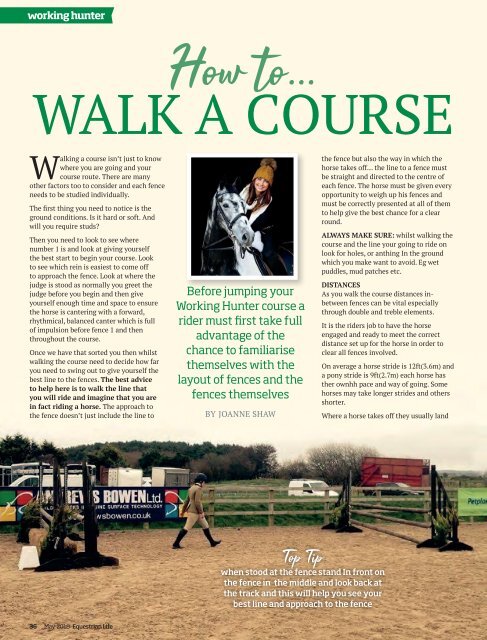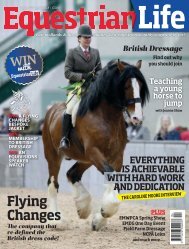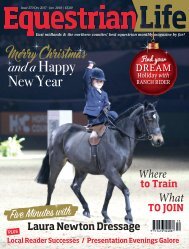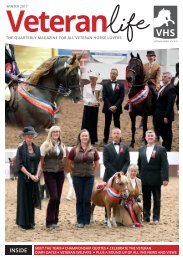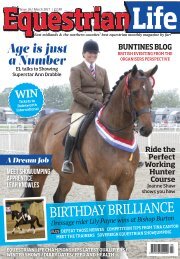Equestrian Life May 2018 Issue
Create successful ePaper yourself
Turn your PDF publications into a flip-book with our unique Google optimized e-Paper software.
working hunter<br />
How to...<br />
WALK A COURSE<br />
Walking a course isn’t just to know<br />
where you are going and your<br />
course route. There are many<br />
other factors too to consider and each fence<br />
needs to be studied individually.<br />
The first thing you need to notice is the<br />
ground conditions. Is it hard or soft. And<br />
will you require studs?<br />
Then you need to look to see where<br />
number 1 is and look at giving yourself<br />
the best start to begin your course. Look<br />
to see which rein is easiest to come off<br />
to approach the fence. Look at where the<br />
judge is stood as normally you greet the<br />
judge before you begin and then give<br />
yourself enough time and space to ensure<br />
the horse is cantering with a forward,<br />
rhythmical, balanced canter which is full<br />
of impulsion before fence 1 and then<br />
throughout the course.<br />
Once we have that sorted you then whilst<br />
walking the course need to decide how far<br />
you need to swing out to give yourself the<br />
best line to the fences. The best advice<br />
to help here is to walk the line that<br />
you will ride and imagine that you are<br />
in fact riding a horse. The approach to<br />
the fence doesn’t just include the line to<br />
Before jumping your<br />
Working Hunter course a<br />
rider must first take full<br />
advantage of the<br />
chance to familiarise<br />
themselves with the<br />
layout of fences and the<br />
fences themselves<br />
BY JOANNE SHAW<br />
the fence but also the way in which the<br />
horse takes off… the line to a fence must<br />
be straight and directed to the centre of<br />
each fence. The horse must be given every<br />
opportunity to weigh up his fences and<br />
must be correctly presented at all of them<br />
to help give the best chance for a clear<br />
round.<br />
ALWAYS MAKE SURE: whilst walking the<br />
course and the line your going to ride on<br />
look for holes, or anthing In the ground<br />
which you make want to avoid. Eg wet<br />
puddles, mud patches etc.<br />
DISTANCES<br />
As you walk the course distances inbetween<br />
fences can be vital especially<br />
through double and treble elements.<br />
It is the riders job to have the horse<br />
engaged and ready to meet the correct<br />
distance set up for the horse in order to<br />
clear all fences involved.<br />
On average a horse stride is 12ft(3.6m) and<br />
a pony stride is 9ft(2.7m) each horse has<br />
ther ownhh pace and way of going. Some<br />
horses may take longer strides and others<br />
shorter.<br />
Where a horse takes off they usually land<br />
Top Tip<br />
when stood at the fence stand In front on<br />
the fence in the middle and look back at<br />
the track and this will help you see your<br />
best line and approach to the fence<br />
36 <strong>May</strong> <strong>2018</strong> <strong>Equestrian</strong> <strong>Life</strong>


